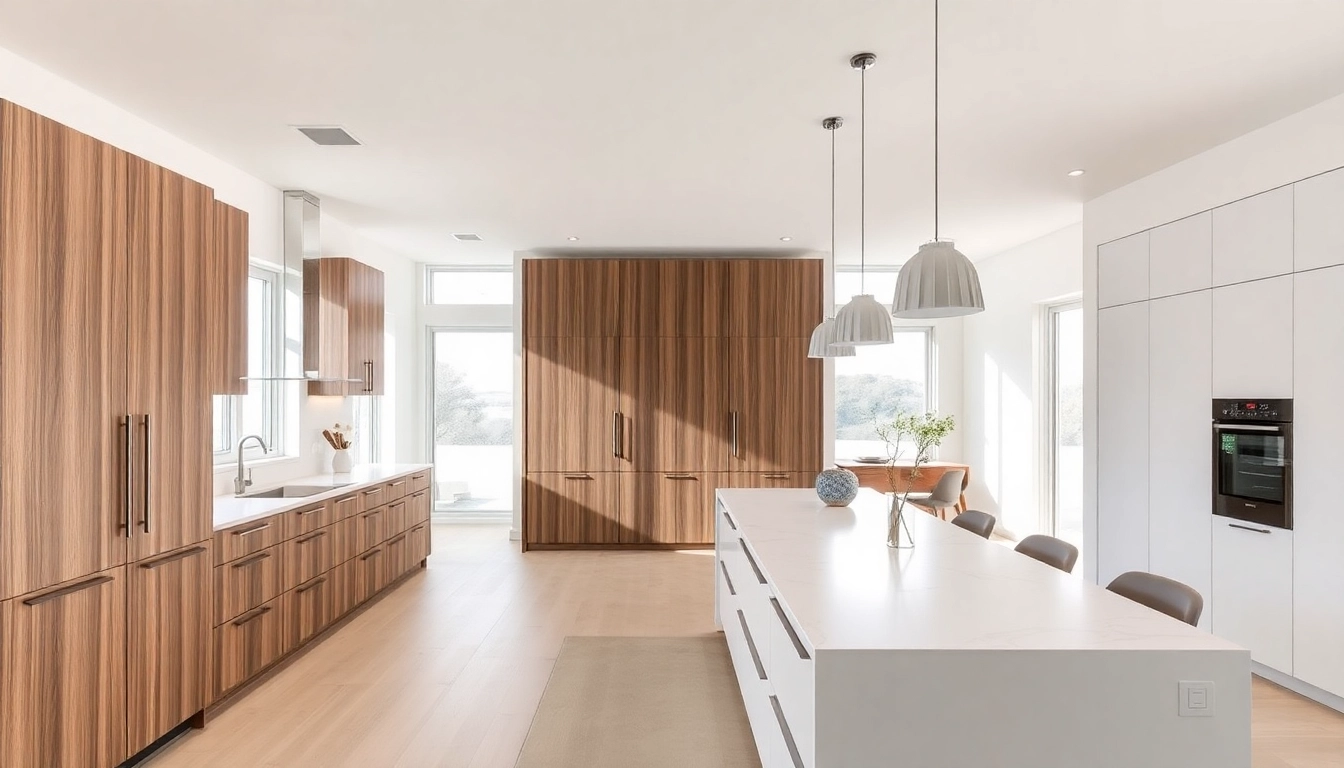Understanding the Basics of Remodeling
What Does Remodeling Entail?
Remodeling, often synonymous with renovation in common parlance, involves the comprehensive process of transforming a space’s structure, design, and functionality to meet new aesthetic preferences or modern standards. Unlike simple cosmetic updates, remodeling encompasses significant alterations—such as adding new rooms, removing or relocating walls, updating electrical and plumbing systems, and installing new fixtures and finishes. The goal is to enhance both the visual appeal and the functional efficiency of a property, ultimately increasing its value and usability.
For homeowners contemplating a remodeling project, understanding the core elements involved is crucial. Typically, remodeling starts with detailed planning, followed by design, and then execution. The scope may vary from minor updates like kitchen backsplash replacements to complete home overhauls. Each project is unique, requiring tailored approaches that consider budget, timeline, structural requirements, and personal preferences.
Types of Remodeling Projects
Remodeling projects are diverse and can be classified into several categories based on scope, focus, and purpose:
- Kitchen Remodeling: Upgrading appliances, cabinets, countertops, flooring, and lighting to create a more functional, modern space.
- Bathroom Remodeling: Renovating fixtures, vanities, tiles, and plumbing to improve comfort and aesthetic appeal.
- Basement Finishing: Transforming unused or underutilized spaces into livable areas such as family rooms, home theaters, or home offices.
- Whole House Remodeling: Major overhauls that involve updating multiple rooms, improving structural elements, or expanding living spaces.
- Exterior Remodeling: Enhancing curb appeal through siding, roofing, window replacements, or outdoor living spaces like patios and decks.
- Room Additions: Extending the existing footprint by adding new rooms or stories to accommodate changing family or lifestyle needs.
Each of these categories requires specific expertise, materials, and planning to ensure successful completion and longevity.
Key Differences Between Renovating and Remodeling
It’s essential to distinguish between remodeling and renovating, as they often overlap but serve different purposes. According to Collins Dictionary, remodeling refers to changing or altering the structure, style, or form of something—implying a significant transformation.
Renovating, on the other hand, typically involves cosmetic updates aimed at restoring or enhancing the existing condition without altering the fundamental structure. For example, repainting walls, replacing fixtures, or refinishing floors are renovation activities.
In practice, remodeling projects may include expanding spaces, removing walls, or installing new layouts, while renovations might focus on interior painting, new lighting, or upgrading appliances. Understanding these distinctions helps set realistic expectations, budget allocations, and planning strategies.
Both approaches can significantly increase home value and functionality, but remodeling tends to be more extensive and resource-intensive.
Planning Your Remodeling Project Effectively
Setting Achievable Goals and Budget
Effective planning begins with defining clear, realistic goals for your remodeling project. Consider questions like:
- What are the main issues or limitations of my current space?
- What are my must-have features versus nice-to-have upgrades?
- How will the remodel improve my daily life or increase property value?
Simultaneously, establish a detailed budget framework. According to industry data, a typical major home remodel can range from $20,000 to $100,000 or more, based on scope and location. Setting a firm budget helps prioritize spending and avoid overruns. It’s wise to allocate around 10-15% for unforeseen expenses or changes during construction.
Consulting with a professional contractor or using online estimates can help refine your budget. Remember, a well-planned project balances aspirations with financial reality.
Designing for Functionality and Style
Designing a remodeled space requires harmonizing personal taste with practicality. Engage professional designers or leverage digital tools to visualize layouts, color schemes, and materials. Consider:
- Traffic flow and spatial efficiency
- Natural light and ventilation
- Storage solutions
- Material durability and maintenance
- Future adaptability of the space
Incorporate current trends like open-concept layouts, smart home technology, and eco-friendly materials to future-proof your investment.
Remember, good design is about creating spaces that reflect your lifestyle while also considering resale value. Prioritize functionality alongside aesthetics for satisfying, sustainable results.
Selecting the Right Remodeling Contractor
Choosing a qualified and trustworthy contractor is pivotal to project success. Look for contractors with:
- Proper licensing and insurance
- Strong reputation and positive references
- Portfolio of completed projects similar in scope
- Transparent bidding and contract process
- Good communication skills and professionalism
Conduct interviews, ask for detailed proposals, and verify credentials. Local firms such as Bryce & Doyle Craftsmanship and others in Rochester, NY, exemplify seasoned expertise committed to quality.
Investing time in selecting the right contractor reduces risks, minimizes delays, and ensures your vision is accurately realized.
Executing Successful Remodeling with Quality
Permitting and Code Compliance
Ensuring your remodeling project adheres to local building codes and zoning regulations is essential. Obtain necessary permits before starting work to avoid legal issues or costly rework. A professional contractor will handle permit application processes and ensure compliance with safety standards, electrical codes, and environmental regulations.
Additionally, designing with code in mind prevents future obstacles during resale or zoning inspections.
Using Quality Materials and Techniques
The longevity and visual appeal of your remodeling depend heavily on material selection and construction techniques. Prioritize high-quality, durable materials suited to the environment and usage. For example:
- Hardwood or waterproof flooring for kitchens and bathrooms
- EPA-certified low-VOC paints for healthier indoor air quality
- Steel-reinforced framing for structural integrity
- Energy-efficient appliances and fixtures
Employ skilled craftsmanship and modern construction methods to ensure safety, efficiency, and a refined finish.
Managing Timeline and Expectations
Effective project management involves establishing realistic timelines, clear milestones, and open communication. Prepare for potential delays due to material availability or unforeseen issues. Regular check-ins and progress reports help keep the project on track.
Understanding that quality takes time is crucial; rushing can compromise results and lead to future repairs. A professional contractor will assist in setting achievable schedules and managing client expectations throughout the process.
Measuring Results and Enhancing Home Value
Post-Remodeling Inspection and Adjustments
After project completion, conduct thorough inspections to confirm that all work meets the agreed-upon standards. Address any deficiencies or touch-ups promptly to ensure satisfaction and durability.
Maintain documentation, warranties, and manuals for future reference and maintenance.
Increasing Home Resale Value through Remodeling
Well-executed remodeling can significantly boost your property’s market value. Focus on high ROI features such as updated kitchens and bathrooms, energy-efficient systems, and curb appeal enhancements. Data suggests that kitchen remodels tend to recoup about 70-80% of costs at resale, making them highly strategic investments.
Additionally, modern renovations attract buyers by aligning with current market trends, reducing time on the market.
Maintaining Your Renovated Space
Ongoing maintenance preserves the beauty and functionality of your remodel. Regular inspections, timely repairs, and using recommended cleaning products extend lifespan. For example, sealing grout lines prevents water damage and mold growth in bathrooms.
Staying proactive in maintenance ensures your investment remains valuable and attractive for years to come.
Innovative Trends and Tips in Remodeling
Sustainable and Eco-Friendly Remodeling
Incorporating sustainability into remodeling is increasingly vital. Use eco-friendly materials like bamboo flooring, recycled glass countertops, and low-impact paints. Implement energy-saving features such as solar panels, high-efficiency insulation, and smart thermostats.
These strategies reduce operational costs, lower carbon footprints, and appeal to environmentally conscious buyers.
Smart Home Integration
Modern remodeling often includes smart home technologies that enhance convenience, security, and energy efficiency. Installing smart lighting, automated blinds, home automation systems, and voice-controlled devices can transform a traditional home into a futuristic living space.
Proper integration requires planning electrical and network systems during initial design phases to ensure seamless operation.
Creative Design Ideas for Modern Living
Embrace innovative concepts such as open-concept kitchens, minimalist aesthetics, multi-functional furniture, and biophilic design—bringing nature indoors with plants and natural light. Incorporate statement features like statement ceilings, accent walls, or unique materials to create personalized spaces.
Staying updated with the latest trends from industry leaders and interior designers helps ensure your remodel remains stylish and functional.






